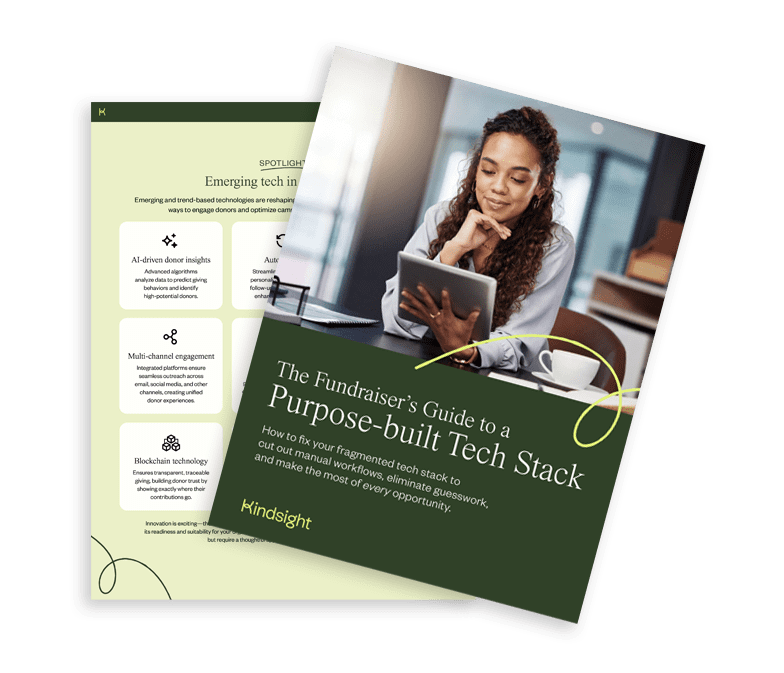
Donor segmentation allows nonprofits to show the right message to the right people at the right time.
Your supporters aren’t all the same—so why treat them that way? Segmentation allows you to group donors by key traits and tailor communications that resonate with each audience.
That level of personalization is what cuts through the noise. One-size-fits-all messages are easy to ignore, especially in a crowded inbox. Targeted outreach, on the other hand, boosts engagement and builds stronger relationships.
With the right segmentation strategy, your team communicates more effectively—without increasing your workload. Here’s how segmentation works, why it matters, and how to use it to drive better results.
What is donor segmentation?
Donor segmentation means grouping your supporters by shared traits or behaviors, typically in your fundraising CRM, so you can target them with more relevant campaigns. These traits might include giving history, location, or engagement level.
Instead of sending a single message to your entire donor base, you customize outreach for specific groups. This approach helps make your communication feel more relevant and intentional. As a result, campaigns are more likely to grab attention, inspire action, and drive better overall results.
Think of it like real life: you don’t talk to a close friend the same way you would talk to a new acquaintance. The same principle applies to donor communication. Segmentation enables nonprofits to adjust tone, timing, and content based on the donor group.
Common donor segments include high-value donors, recurring givers, event attendees, and local supporters. You can also segment by age group, communication preferences, or past donation amount. The options are nearly endless—and each one brings you closer to more effective messaging.
Why segment your donors?
Donor segmentation strengthens your fundraising by making every message more targeted and effective. Here’s why it matters.
Personalized communication drives results. Studies show that 72% of people only engage with messages that are tailored to their interests. Segmentation helps your outreach feel specific and intentional—never generic (page 1 of the PDF).
It improves donor engagement. Sending the right message to the right donor means your communications are more likely to land. Without it, you risk sending irrelevant updates, which may lead donors to tune out altogether.
You will better understand your donor base. When you create segments, you build donor profiles. These insights help you track patterns, target campaigns, and build relationships that last.
It saves your team time and reduces costs. Instead of blasting every message to everyone—or crafting individual emails—you create a few strategic messages that speak directly to key donor groups.
It drives better retention. Donor retention averages only 20% for new supporters. But repeat donors are more likely to stick around when your messages feel personal and relevant. Segmenting your audience allows for that kind of relationship-building at scale.
It stretches your campaign budget. Targeting only the most relevant donors—like local supporters for an in-person event—makes expensive tactics like direct mail more effective and less wasteful.
What data do you need to segment your donors?
Effective donor segmentation starts with clean, centralized data. To build strong segments, you’ll need information like giving history, donation amount, communication preferences, and demographic details such as age, location, and donor behavior.
The more complete your donor profiles, the more precise your segments—and the more relevant your messaging. A modern nonprofit CRM helps by automatically organizing this data and highlighting patterns you can use to refine your outreach.
With the right tools in place, every message becomes more targeted, more personal, and more likely to inspire action.
Ready to dig deeper into data?
Check out our Ultimate Guide to Data-led Fundraising! See how to turn data into action (and learn to love data along the way).

Donor segmentation strategies
Donor segmentation works best when based on real data like giving behavior, demographics, or interests. You can use a single lens or combine several for a more precise, effective strategy.
Segment by affinity for a cause, topic, or event
Donors are more likely to give when the cause matches their personal values. Segmenting by affinity allows you speak directly to what they care about most.
Many people give because the cause is personal to them. They may have a strong emotional tie to a specific issue—like education, clean water, or animal welfare. When your message reflects that passion, it feels more relevant and builds stronger donor relationships.
Example: A donor who supports wetland conservation is more likely to respond to a campaign protecting local marshes than to a broad message about environmental issues. Targeted appeals like this show donors that your organization truly understands what motivates them.
Multi-lens modeling—analyzing donors through multiple data points like giving history, event participation, and stated interests—helps you identify affinity groups. This approach reveals what each donor values most, so you can tailor your outreach accordingly.
Segment by donor demographics
Demographic factors like age, gender, income, and location shape how donors engage with your nonprofit. Understanding these helps you tailor messages that truly connect.
Age and generation impact preferences. Baby Boomers often respond well to direct mail or personal calls. Millennials tend to prefer digital outreach like emails or social media. Adapting to these habits makes your communication more effective.
Gender influences giving behavior too. Studies show women are generally more likely to give and give more than their male counterparts, especially when they feel personally connected to the cause.
Income level also matters. Knowing donors’ giving capacity helps set appropriate donation asks and prevents donor fatigue. This increases the likelihood of repeat donations.
Example: A nonprofit organization might send personalized mail appeals to older donors while using social media campaigns to engage younger supporters. This approach respects each group’s preferred communication style and boosts engagement.
Segment by actions or behaviors
Donor actions and behaviors reveal how engaged they are and what motivates them. Segmenting by behavior lets you tailor communication based on real donor preferences and choices.
How a donor joined your organization—or a different nonprofit organization—often shows what interests them most. Someone who gave after attending a gala may prefer social or networking events. A donor from a digital campaign might respond better to online outreach.
Event participation is a strong indicator of interest. Donors who regularly attend workshops on a specific issue likely want more detailed updates and targeted communications on that topic.
Tracking campaign engagement is valuable too. Donors who share or promote your messages could become ambassadors for your organization’s mission. They may be open to deeper involvement when asked appropriately.
Segment by size of gift
Segmenting donors by gift size helps nonprofits tailor communications to each donor’s giving capacity. This approach nurtures relationships efficiently and respects donors’ levels of commitment.
Major donors expect personalized communication. They often want deeper connections and updates on how their gifts make a tangible difference. Offering special experiences—like personal calls, exclusive events, or meetings with leadership—strengthens these relationships and increases the potential for future major gifts.
Don’t forget your smaller donors
Regular smaller donors are equally important. Their consistent support builds a reliable funding base. Messaging that highlights the collective impact of steady donations helps these donors feel part of a larger mission. Sharing stories about the power of recurring gifts inspires loyalty and potentially increases giving.
This communication strategy based on gift size also helps nonprofits use their resources wisely. It’s important to stay connected with all donor segments, but focusing multi-touch, personalized outreach on high-impact donors delivers the greatest return. This targeted approach maximizes engagement and donation potential while keeping overall campaign efforts efficient and effective.
Segment by donation frequency
Donation frequency shows how committed a donor is to your cause. Use it to time your outreach to their giving rhythm.
Annual donors
These donors typically give once per year, often around the holidays, during major fundraising drives, or at the end of the year. Tradition, seasonal impact, and tax incentives often drive their giving.
Send them reminders ahead of their usual giving window and follow up with a summary of how their annual support has moved the mission forward.
Monthly donors
Monthly donors are your most reliable supporters and often the most cost-effective to retain. They appreciate consistency and transparency.
Keep these recurring donors engaged with regular progress updates, insider insights, and occasional perks like early event invites or recognition in newsletters. Reinforce how their steady support builds long-term impact for your nonprofit.
First-time donors
First-time donors are at a critical turning point—they’ve shown interest but haven’t built loyalty to your organization yet. A thoughtful, personalized thank-you helps turn a one-time gift into a long-term relationship.
Then, invite them into the story: show them the specific impact of their gift, and introduce them to the broader mission. Follow up with a welcome series that shares your values, goals, and real-life outcomes.
Returning donors
These donors have given more than once but haven’t yet committed to a recurring pattern. They’re likely open to giving more frequently—if they feel connected.
Acknowledge their ongoing interest and highlight how their past gifts have helped create change. Test messages that promote monthly giving, emphasize convenience, or frame their generosity as part of a larger movement.
Segment by interests
Donors are drawn to different aspects of your mission. Segmenting by interest allows you to personalize content and deepen engagement across a variety of touchpoints.
Interested in volunteering
Some donors want to contribute their time, not just their money. Invite them to volunteer opportunities, hands-on events, or behind-the-scenes activities where they can see the impact of your work up close. They’re often strong candidates for long-term support and word-of-mouth advocacy.
Interested in education
These donors want to learn more about your mission and the issues you address. Share detailed reports, webinars, or content that clearly breaks down the issues you address and the progress you’re making. The more informed they feel, the more likely they are to stay engaged and spread your message.
Focused on specific aspects of your mission
These donors have a clear passion for one part of your work—like youth programs, clean water initiatives, or legislative advocacy. Send them targeted updates that speak directly to that interest. When donors feel seen and understood, they’re more likely to continue giving and stay involved.
Multi-interest donors
This group cares about many aspects of your nonprofit and engages in multiple ways. They might donate, volunteer, attend events, and follow your news closely. Keep them connected with a steady mix of updates, invitations, and insider content to match their broad enthusiasm.
Segment by communication preferences
Donors are more likely to engage when you reach them through their preferred channel. Some donors prefer to receive fundraising emails, while others respond better to direct mail, text, phone calls, or in-person outreach. Respecting those preferences makes your message feel more personal and less intrusive.
You can gather this information through surveys, sign-up forms, or one-on-one interactions. Then, tailor your communication strategy to match their expectations, whether that’s a quick text update or a mailed impact report. This small adjustment builds trust, improves response rates, and shows donors you value how they want to be engaged.
The role of data and tools
Strong segmentation relies on more than guesses and assumptions—it depends on accurate, accessible donor data. Without the right tools, it’s hard to track donor behavior, identify patterns, or build segments that actually improve engagement.
Modern donor management systems simplify this process. Instead of sorting through spreadsheets, you can filter your list by giving history, event attendance, location, or interests in a few clicks. Some fundraising intelligence platforms include generative AI tools for nonprofits that draft personalized emails and direct mail based on each segment’s unique characteristics.
This technology makes it easier to create targeted, relevant communication that resonates with donors. By automating personalization, nonprofits save time while ensuring each message feels thoughtful and tailored to the recipient’s interests and giving behavior.
Overwhelmed by your tech stack?
Fundraising teams face an abundance of manual tasks and disconnected, outdated systems. Our guide will give you actionable strategies for overcoming tech obstacles and unlocking fundraising opportunities.

Better insights equal better results
These insights translate directly to better targeting. For example, a nonprofit could use behavioral data to shift from sending generic messages to tailoring campaigns by region and giving history. As a result, they could significantly increase their response rate—without increasing effort.
With the right tools in place, segmentation becomes a strategic advantage—not just another task. The next step is using your segments to drive results.
How to effectively use donor segments
Donor segmentation only adds value if you use it strategically. The goal isn’t just to organize your list—it’s to make every message more relevant, personal, and impactful.
These best practices will help you turn segments into stronger relationships and better fundraising results.
Ensure your segments are meaningful
Donor segments should be actionable, scalable, and aligned with your goals. Not every segment will be useful—focus on the ones that drive action and results.
The best donor segments are specific enough to personalize communication, but broad enough to justify the effort. If a segment is too narrow, you may not have the volume to justify a tailored message. If it’s too broad, your message may be reduced in its impact and relevance.
Start by identifying segments that align with your fundraising goals or strategic priorities. What groups are most important to reach this year? Which segments could benefit from more focused outreach or higher-touch engagement?
Segmentation should simplify your strategy, not overcomplicate it. Use your nonprofit CRM to create clear, searchable categories that you can act on with confidence.
Target your “ask” appropriately
Your donation request should match each segment’s capacity and likely motivation.
For example, college students may not be ideal targets for major gifts, but they might respond well to small, recurring donation requests. A $5 or $10 monthly gift could feel accessible and meaningful to them.
On the other hand, donors who have given large one-time gifts or shown long-term commitment might be strong candidates for a major gift appeal. Use segmentation to identify these high-capacity donors and shape your messaging around impact, exclusivity, or long-term vision.
Matching your ask to each segment increases both your success rate and donor satisfaction.
And don’t forget about having donation tiers and levels in your donation forms; this can help guide your lower to mid-tier gifts.
Improve your donor stewardship
Tailored donor stewardship builds loyalty and strengthens long-term donor relationships.
Focus on segments that show strong retention or engagement, and recognize their contributions in ways that resonate. This could include public acknowledgments, handwritten thank-you notes, or personalized updates on projects they care about.
When donors feel seen and valued, they’re more likely to stay connected and continue giving. Use segmentation to deliver the right message at the right time—and show them the impact they’re making.
Analyze engagement by donor segment
Tracking engagement by segment helps you understand what’s working—and what’s not.
Use your segmentation strategy to gather data on donor behavior, like open rates, event attendance, or response to campaigns. You may discover that some segments engage more consistently, while others need a different approach.
This insight helps you refine your strategy over time. Instead of spreading efforts evenly, you can prioritize high-engagement groups and rework messaging for segments that show lower response.
Targeted email automations
Automated email campaigns work best when tailored to specific donor segments.
Using segmentation, you can match each message to the donor’s interests, behaviors, or giving history. For example, new donors might receive a welcome series, while major donors get impact-driven updates or personalized thank-you emails.
Email automation software makes this easy to manage at scale. Pair it with fundraising intelligence tools to define meaningful segments and deliver messaging that drives deeper engagement.
Donor segmentation is essential for effective fundraising
Donor segmentation helps nonprofits build stronger relationships through targeted, personalized communication. By grouping supporters based on traits like giving history, interests, demographics, and behaviors, you send messages that truly resonate. This approach increases engagement, improves retention, and boosts campaign performance across the board.
With the right data and tools, segmentation becomes a strategic advantage—not just a marketing task. CRMs and fundraising intelligence platforms make it easy to track donor behavior and tailor outreach by segment. These insights allow you to scale personalization without sacrificing efficiency.
The key is using your segments with purpose. Focus on meaningful groupings, match your messaging to donor motivation, and continuously measure what’s working. When segmentation guides your outreach, your fundraising becomes more effective—and your donor relationships last longer.
Be the first to read our resources.
The world is changing quickly—and our resources help you stay on top of it all. Sign up to get new insights, success stories, and more, sent right to your inbox.




